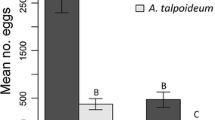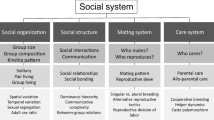Abstract
Oviparous females of the haplodiploid, facultatively viviparous thrips Elaphrothrips tuberculatus(Thysanoptera: Phlaeothripidae) guard their eggs against female conspecifics and other egg predators. The intensity of maternal defense increases with clutch size. Field and laboratory observations indicate that cannibalism by females is an important selective pressure favoring maternal care. Experimental removals of guarding females showed that egg guarding substantially increases egg survivorship and that the survivorship of undefended eggs is higher in the absence of nonguarding female conspecifics than in their presence. The fecundity of viviparous females increases with the number of eggs cannibalized. The reproductive success of oviparous females increases with body size and local food density and decreases with local density of breeding females. Social behavior may not have advanced beyond maternal care in Elaphrothrips tuberculatusbecause, relative to Hymenoptera, capabilities for helping relatives are few or nonexistent, and the causes of variation in female reproductive success are not influenced easily by cooperation among females.
Similar content being viewed by others
References
Alexander, R. D., Noonan, K., and Crespi, B. J. (1989). The evolution of eusociality. In Sherman, P. W., Jarvis, J., and Alexander, R. D. (eds.),The Natural History and Social Behavior of Naked Mole Rats (in press).
Ananthakrishnan, T. N. (1984).Bioecology of Thrips, Indira, Oak Park, Mich.
Andersson, M. (1984). The evolution of eusociality.Annu. Rev. Ecol. Syst. 15: 165–189.
Ashe, J. S. (1987). Egg chamber production, egg protection, and clutch size among fungivorous beetles of the genusEumicrota (Coleoptera: Staphylinidae) and their evolutionary significance.ZooJ. J. Linn. Soc. 90: 255–273.
Bagnall, R. S. (1915). On a collection of Thysanoptera from the West Indies with descriptions of new genera and species.Zool. J. Linn. Soc. 32: 495–507.
Barash, D. P. (1975). Evolutionary aspects of parental behavior: Distraction behavior of the alpine accentor.Wilson Bull. 87: 367–373.
Batra, S. W. T. (1964). Behavior of the social beeLasioglossum zephyrum within the nest (Hymenoptera; Halictidae).Insectes Soc. 11: 159–185.
Bourke, A. (1988). Worker reproduction in the higher eusocial Hymenoptera.Q. Rev. Biol. 63: 291–311.
Coleman, R. M., Gross, M. R., and Sargent, R. C. (1985). Parental investment decision rules: A test in bluegill sunfish.Behav. Ecol. Sociobiol. 18: 59–66.
Crespi, B. J. (1986a). Territoriality and fighting in a colonial thrips,Hoplothripspedicularius, and sexual dimorphism in Thysanoptera.Ecol. Entomol. 11: 119–130.
Crespi, B. J. (1986b). Size assessment and alternative fighting tactics inElaphrothrips tuberculatus (Insecta: Thysanoptera).Anim. Behav. 34: 1324–1335.
Crespi, B. J. (1987).Behavioral Ecology of Mycophagous Thysanoptera, Ph.D. dissertation, University of Michigan, Ann Arbor.
Crespi, B. J. (1988a). Risks and benefits of lethal male fighting in the colonial, polygynous thripsHoplothrips karnyi (Insecta: Thysanoptera).Behav. Ecol. Sociobiol. 22: 293–301.
Crespi, B. J. (1988b). Sex ratio selection in a bivoltine thrips. I. Conditional sex ratio manipulation and fitness variation.Evolution 42: 1199–1211.
Crespi, B. J. (1988c). Alternative male mating tactics in a thrips: Effects of sex ratio variation and body size.Am. Midl. Nat. 119: 83–92.
Crespi, B. J. (1989). Facultative viviparity in a thrips.Nature 337: 357–358.
Edgerly, J. S. (1987). Maternal behavior of a webspinner (order Embiidina).Ecol. Entomol. 12: 1–11.
Eickwort, G. C. (1981). Presocial insects. In Hermann, H. R. (ed.),Social Insects, Vol. 2, Academic Press, New York, pp. 199–280.
Fox, L. R. (1975). Cannibalism in natural populations.Annu. Rev. Ecol. Syst. 6: 87–106.
Geret, G. (1964). Le comportement d'oophagie differentielle chezPolistes gallicus L. (Hymenoptera, Vespidae).Insectes Soc. 11: 343–382.
Grieg-Smith, P. W. (1980). Parental investment in nest defense by stonechats (Saxicola torquata).Anim. Behav. 28: 604–619.
Haga, K. (1980). The life-history ofBactridothrips brevitubus (Takahashi) (Idolothripinae).XVI International Congress of Entomology, Kyoto, “Conference of Thysanopterists,” pp. 1–8.
Hamilton, W. D. (1964). The genetical evolution of social behavior. I, II.J. Theor. Biol. 7: 1–52.
Hamilton, W. D. (1972). Altruism and related phenomena, mainly in social insects.Annu. Rev. Ecol. Syst. 3: 193–232.
Hean, A. F. (1943). Notes on maternal care in thrips.J. Entomol. Soc. So. Afr. 6: 81–83.
Kiester, A. R., and Strates, E. (1984). Social behavior in a thrips from Panama.J. Nat. Hist. 18: 303–314.
Lemmetyinen, R. (1971). Nest defense behavior of common and arctic terns and its effects on the success achieved by predators.Omis Fenn. 48: 13–24.
Lin, N. (1964). Increased parasite pressure as a major factor in the evolution of social behavior in halictine bees.Insectes Soc. 11: 187–192.
Litte, M. (1977). Aspects of the social biology of the beeHalictus ligatus in New York State (Hymenoptera, Halictidae).Insectes Soc. 24: 9–36.
Mani, M. S., and Rao, S. N. (1950). A remarkable case of maternal solicitude in a thrips from India.Curr. Sci. 19: 217.
Michener, C. D. (1974).The Social Behavior of the Bees, Harvard University Press, Cambridge, Mass.
Montgomerie, R. D., and Weatherhead, P. J. (1988). Risks and rewards of nest defense by parent birds.Q. Rev. Biol. 63: 167–187.
Patterson, T. L., Petrinovich, L., and James, D. K. (1980). Reproductive value and appropriateness of responses to predators by white-crowned sparrows.Behav. Ecol. Sociobiol. 7: 227–231.
Polis, G. A. (1984). Intraspecific predation and “infant killing” among invertebrates. In Hausfater, G., and Hrdy, S. B. (eds.),Infanticide: Comparative and Evolutionary Perspectives, Aldine Press, New York, pp. 87–104.
Ramakrishna Ayyar, T. V. (1928). A contribution to our knowledge of the Thysanoptera of India.Memoirs Dept. Agr. Entomol. Ser. 10: 217–316.
Robertson, R. J., and Biermann, G. C. (1979). Parental investment strategies determined by expected benefits.Z. Tierpsychol. 50: 124–128.
Stannard, L. J. (1968). The thrips, or Thysanoptera of Illinois.Ill. Nat. Hist. Surv. Bull. 29: 1–552.
Tallamy, D. W. (1982). Age-specific maternal defense inGargaphia solani (Hemiptera: Tingidae).Behav. Ecol. Sociobiol. 11: 7–11.
Tallamy, D. W., and Wood, T. K. (1986). Convergence patterns in subsocial insects.Annu. Rev. Entomol. 31: 369–390.
Ukegbu, A. A., and Huntingford, F. A. (1988). Brood value and life expectancy as determinants of parental investment in male three-spined sticklebacksGasterosteus aculeatus.Ethology 78: 72–82.
West-Eberhard, M. J. (1978). Polygyny and the evolution of social behavior in wasps.J. Kans. Entomol Soc. 51: 832–856.
West-Eberhard, M. J. (1981). Intragroup selection and the evolution of insect societies. In Alexander, R. D., and Tinkle, D. W. (eds.),Natural Selection and Social Behavior, Chiron Press, New York, pp. 3–17.
Author information
Authors and Affiliations
Rights and permissions
About this article
Cite this article
Crespi, B.J. Subsociality and female reproductive success in a mycophagous thrips: An observational and experimental analysis. J Insect Behav 3, 61–74 (1990). https://doi.org/10.1007/BF01049195
Accepted:
Issue Date:
DOI: https://doi.org/10.1007/BF01049195




